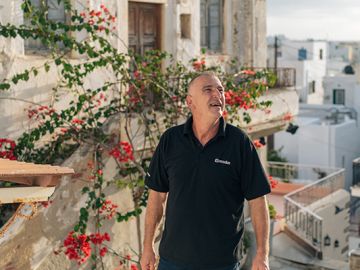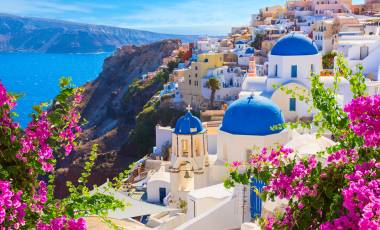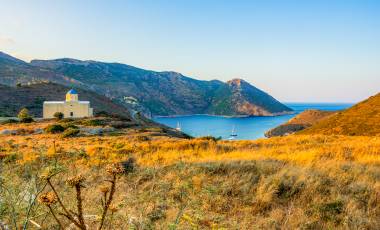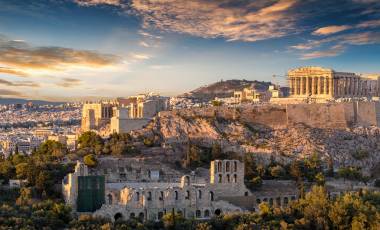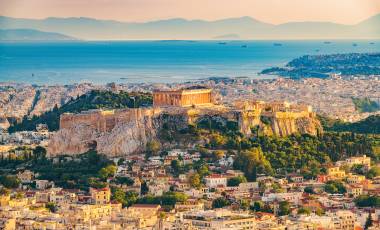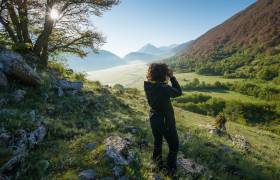Sometimes you want to go where everybody knows your name, and for our veteran Exodus Guide, Thanos Mamas, this pretty much encompasses the entirety of the Aegean Greek Islands. Leaving no family-run restaurant, bustling market stall or local square unturned, you could say Thanos is the ultimate “man about town”. And for us, this comes as no surprise.
For the last two decades Thanos has led our Exodus Trips in what he affectionately coins, “the Land of the Gods” – Greece. His fun-loving, enthusiastic reputation for all-things-Greek precedes him. So, we got in touch with the man himself to ask what he loves most about the Greek islands, and what hidden local gems he’ll show you along the way.
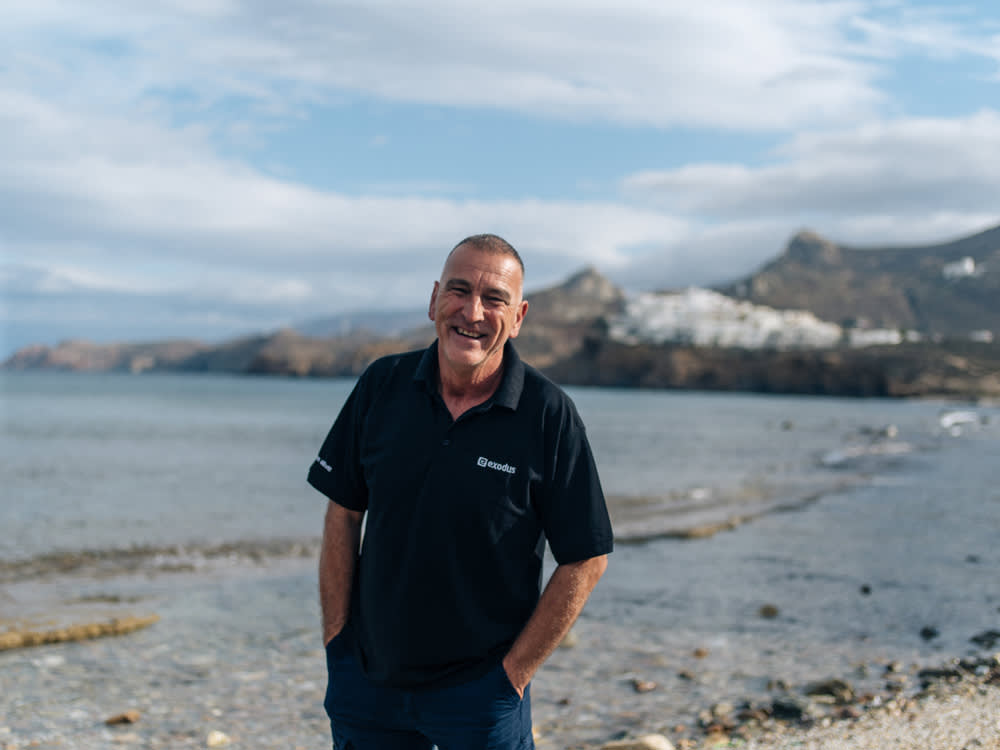
Naxos
Born in the Aegean Greek Islands, Thanos explains, “I take great pride in introducing visitors from all parts of the world to our unique Greek Island communities. You’ll soon find that all of these communities have their own distinct character, local flavour and rich atmosphere.” He continues, “As a keen hiker, I’ve walked almost every trail and path in the country. I feel at home wherever I walk” – and the beautiful mountainous villages in Naxos are no exception.
Boasting the archipelago’s highest peak, Mount Zeus (3294ft), the hilly regions and lush valleys in Naxos are bound to impress every hiking enthusiast. According to Greek mythology, the god of wine, Dionysus, blessed this island with fertility, making it one of the greenest islands in the Cyclades. And it’s thanks to this greenery that Naxos is the only fully self-sufficient island. It produces some of the best olives, honey, grapes, figs, citrus fruit and corn in the whole archipelago. With no need for imports, the dining-out experience in Naxos is even more spectacular.
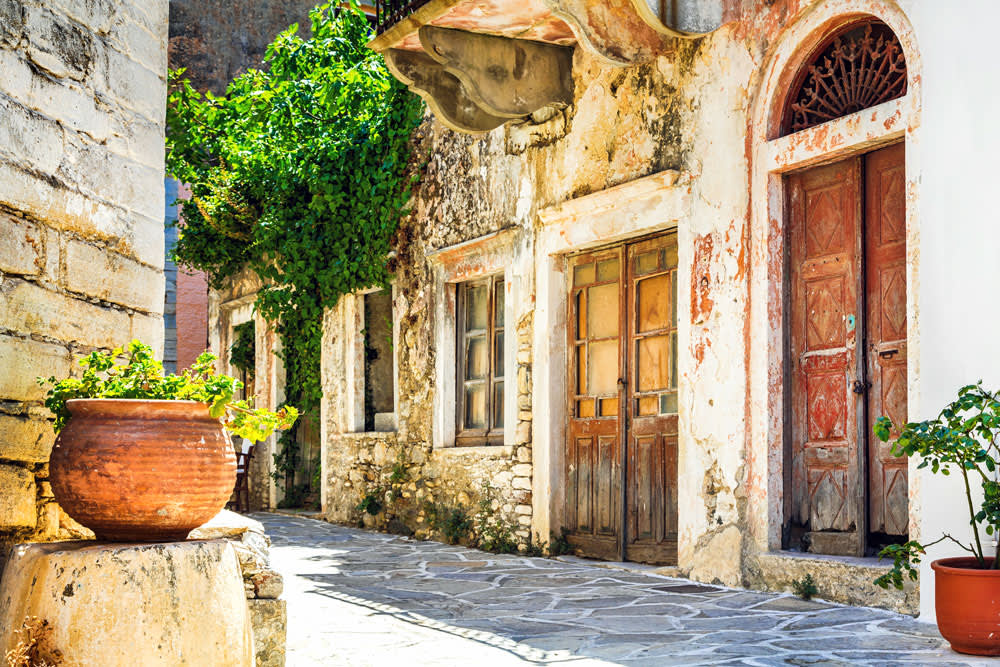
Aside from the beautiful, rich landscape, its main town Hora has a gorgeously inviting waterfront with a labyrinth of steep cobbled alleyways leading up to fortified Venetian mansions. The town had three centuries of Venetian rule, and you can also see Byzantium and Frankish influences, with a number of ancient sites and marble quarries peppered all across the island.
“As we get off the ferry in Naxos on the second day of our Walking on the Greek Islands trip, we leave our luggage off and take a lovely stroll along the promenade”, Thanos comments. “Every time I come here, shop owners and residents think I’m a local – it’s great. Naxos has a very active farming community, which means there’s lots of fantastic local eateries to choose from, but one of my favourite things to do here is to take my group hiking in the Tragea Valley”.
“Walking among the ancient olive trees, I explain to travellers that this area is steeped in Greek mythology dating back to Homer in the lliad. Next, we stop for lunch in the quaint Potami village where Manolis’ family runs the PIGI taverna next to the freshwater springs.” He continues, “Manolis is a local Naxos man and at 97 years old, he still comes around offering everyone seasonal fruits from his trees. He always insists, “Take one for the road”, with a big smile on his face as he waves goodbye to the group. God bless him!”
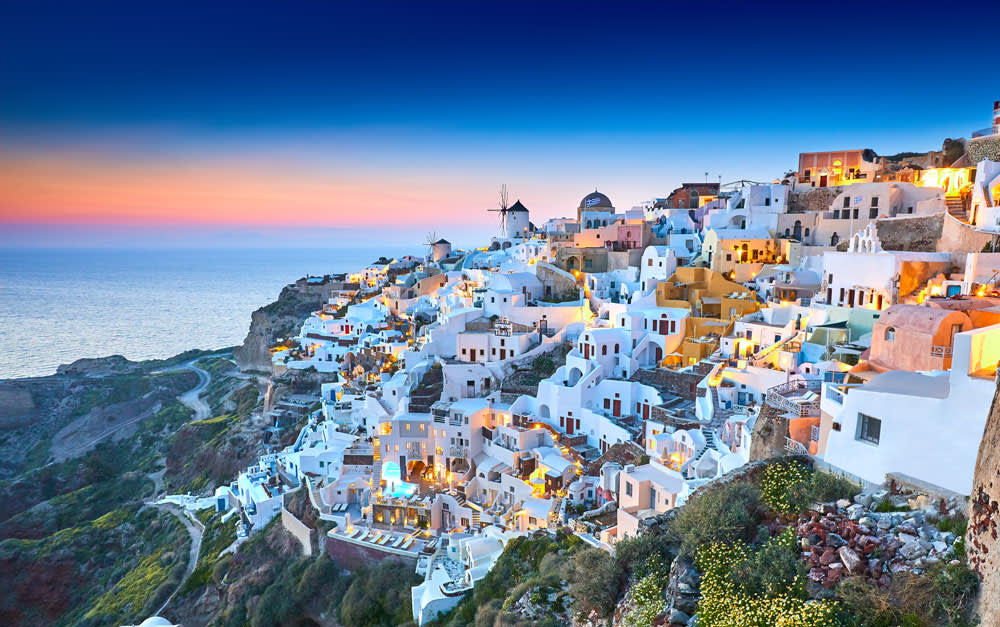
Santorini
Santorini’s iconic, picture-postcard landscape is known the world over. Carved from a massive volcanic eruption almost 3600 years ago, the initial blast left an enormous underwater caldera that has said to have brought about the end of the Minoan civilisation and is also thought to have inspired Plato’s “lost city of Atlantis”. Today, the only remains of this remarkable geological shift are the black sand beaches and the beautifully steep cliffs that jut dramatically out of the crystal blue Aegean Sea.
On day 4 of our Walking the Greek Islands trip we head to Santorini. “Everyone comes up on deck to watch the spectacular arrival into the Caldera as we ferry into Santorini. They all suddenly become speechless, with wide open eyes in a rush to grab their cameras”, Thanos chuckles, “But to be honest, I can’t blame them. Every time I travel to Santorini, it feels like my first time – it’s paradise”.
With a flourishing wine industry, an endless number of high-end restaurants to choose from and lots of fascinating archaeological relics to see, the smouldering Santorini packs a lot into in its 35 square miles. But, perhaps the most impressive site to see in Santorini is the spectacular orange-hued sunsets.
“The hike to Oia really showcases Santorini’s natural beauty – but at sunset this view becomes even more dramatic. We get to see the black lava hills, white Cycladic villages sitting like snow along the cliff tops and the piercing blue Aegean which is a beautiful contrast to one of nature’s finest shows – her sunset.” He continues, “From up high we can see the Crater, the Vast Caldera and our ferry, which looks like a dot in the ocean. Most nights you’ll see crowds breaking into applause as the sun disappears below the horizon, it’s wonderful. This is definitely a place everyone should visit at least once in their lifetime.”
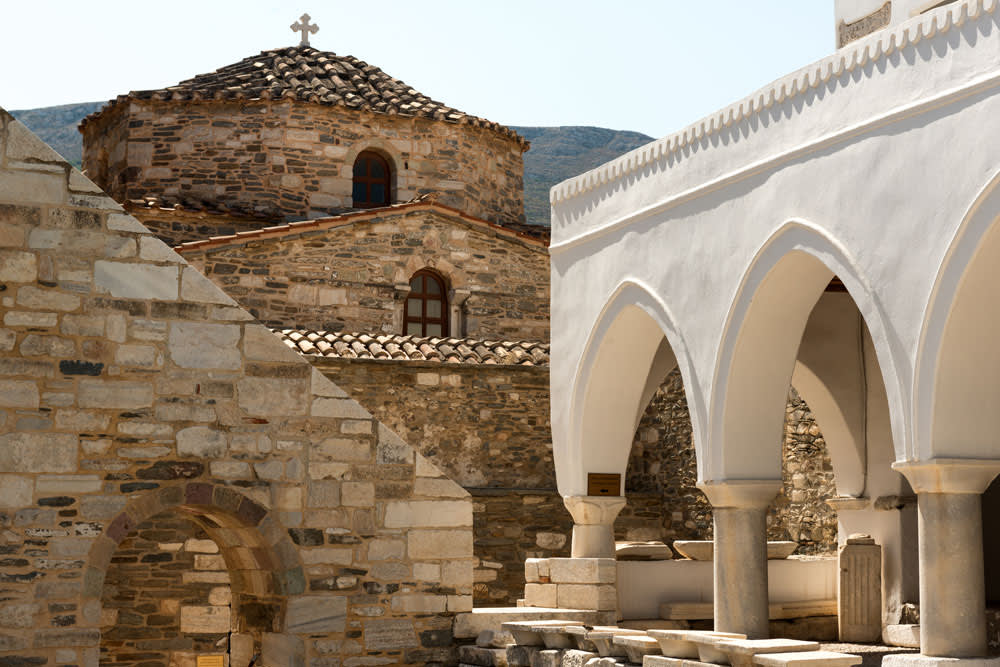
Paros
Aside from excellent opportunities for windsurfing, kitesurfing and diving, the beautiful island of Paros also boasts great hiking trails and a myriad of archaeological gems. The island is well known for its semi-translucent, snow-white marble. Archaeologists have estimated an astonishing 80% of Greek antiquities and masterpieces, like the Venus de Milo, were created from marble slabs sourced on Paros.
On his Walking on the Greek Islands tour, Thanos and his group take the ferry to Paros and dock at sunset. He explains, “Paros is a very mellow, quiet and quintessentially “Greek” Island with delicious cuisine and amazing local wines. Its labyrinthine Old Town is pristine and filled with bustling boutiques, quaint cafes and family-run restaurants. You’ll also find a handful of impressive archaeological sites”.
“The town of Parikia, has a number of historical alleyways, from the 4th century church of Panagia to the walk on the Old Byzantine Path that connects the east with the west coast of the Island. This walkway holds over 1000 years of history. You’ll soon find Paros is full of Parian gems. Around lunchtime on day 7, we arrive in Prodromos village. This quaint Aegean settlement is also known by the locals as, Maria’s village.”
Thanos smiles and continues, “The beautiful Maria and her husband work wonders in their tiny Kallitehniko (arty) cafe under the arches. The group and I usually tuck into local delicacies such as stuffed calamari, chickpeas with roast lamb and fresh octopus with fennel. Even the turquoise blue shores just around the corner, can’t tempt my group from leaving Maria’s Kallitehniko café”.
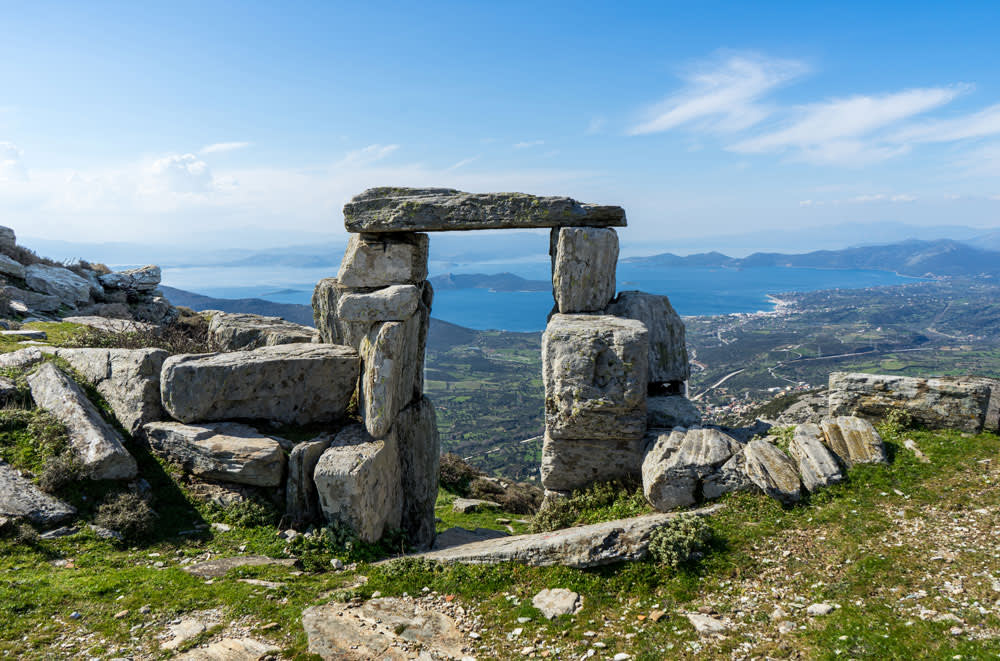
Evia
Holding the title of the second largest island in Greece, Evia unveils rippling vineyards, archaeological relics, spectacular mountain roads and rugged, deserted coastlines just begging to be explored. And on our Mountain & Villages of Evia, you get to do just that. Aside from being a popular holiday spot for Athenians and other mainlanders, Evia remains largely undiscovered by other tourists, which has helped it maintain its authentically Greek culture.
Tucked in between its lush mountain scenery and cold springs, you’ll find Greek, Roman and Mediaeval ruins scattered all across the island. “But what makes Evia so unique are its remarkable gorges”, Thanos explains. “From high plateaus of more than 1000 metres high, these gorges drop dramatically into the Aegean coast and are a must-see when you’re hiking in Evia”.
On day 7 of the Mountains & Villages of Evia tour, we head out on the famous gorge walk to the east coast of Evia. Thanos describes, “We will spend the afternoon walking under ancient plane trees next to the rivers and through time forgotten villages of Greek and Albanian descent. Oranges, mandarins, grapes, cherries and blackberries all grow wild here, depending on the season, and usually in abundance! They are the perfect elevenses”.
“Smelling the local herbs like thyme, oregano and lavender along the way, we stop to take a refreshing dip in the river before coming to Kalogeros”. He continues, “Kalogeros is a quaint, old taverna along the coast, who’s chefs cook up an amazing Greek froutalia. Katerina prepares this dish in the most traditional way, that hasn’t changed in centuries. Using freshly grown potato, onion, oregano, a pinch of saffron, fresh feta cheese and free-range eggs, you can make a mean Greek Omelette – the rest is down to Katerina’s secret recipe.
He smiles and ends the conversation with saying, “All that’s left to do is wash it down with a glass of their own barrel aged wine under the grapevine and enjoy the glorious views of the Aegean. It’s simply the icing on the cake after a day out walking in the Gorge”.
If our friendly guide Thanos has inspired you to find out more about our adventure holidays in Greece, click here.
